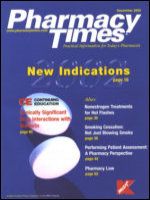Almotriptan (Axert)
IntroductionApproximately 20% of women and 6% of men in the United States suffer from migraine headaches. The patho-physiology of migraine headaches remains unknown. Activation of several different neuronal pathways has been linked to the etiology of migraine headaches. The most recognized probable etiology involves vasodilation of cranial arteries and release of proin-flammatory peptides from nerve endings. Almotriptan is the newest member of a growing class of triptans, more commonly known as serotonin (5HT) inhibitors. Almotriptan was approved for marketing in the United States by the FDA in May 2001 (Axert, Pharmacia Inc., Chicago, IL) for the treatment of migraine headaches with or without aura in adult patients. (1,2)
Mechanism of ActionsSimilar to other triptans, almotrip-tan directly binds to 5HT and 5HT receptors. Compared to sumatriptan, almotriptan is 25 times more potent in human meningeal arteries. Cranial blood vessels are regulated via 5HT receptors, while central trigeminal neuronal traffic in the upper cervical spinal cord is controlled via 5HT. Triptans appear to inhibit activation of the trigeminovascular system. Activation of these receptors has been associated with vasoconstriction and a decreased release of proinflammatory peptides.
Following oral administration, 70% of almotriptan is absorbed, and peak plasma concentration is reached in approximately 1 to 3 hours. The mean elimination half-life of almotriptan is about 3 to 4 hours. Almotriptan is primarily excreted renally (75%) and needs to be adjusted for patients with impaired renal function. A single dose of 6.25 or 12.5 mg orally is effective for the treatment of acute migraine headaches. (3,4)
Trial HighlightsThe safety and efficacy of almotrip-tan have been studied in three major clinical studies. In a large study, 176 patients were randomized to placebo, 360 patients to 6.25 mg almotriptan, and 370 patients to 12.5 mg almotrip-tan. Patients were instructed to treat moderate and severe migraine headaches. The primary end point was overall response at 2 hours following treatment. Sixty-four percent of patients reported mild or no pain 2 hours following treatment in the 12.5-mg group compared to 55.6% in the 6.25-mg group and only 33% in the placebo group. The overall response was significantly better for both the 12.5- and 6.25-mg groups compared to the placebo group. In addition, significantly less photophobia, nausea, and vomiting were reported with the use of almotriptan. Similar results were reported with other clinical studies. (5,6)
Adverse Drug ReactionsAlmotriptan is generally well tolerated. Nausea, dry mouth, and paresthesia have been the most common side effects reported in a small percentage of patients. Almotriptan is contraindi-cated in patients with a known history of ischemic heart disease or uncontrolled hypertension. Two studies have shown the overall side-effect profile and tolerability of almotriptan to be significantly better than with suma-triptan. In a major study, 1,173 patients were randomized to almotrip-tan 12.5 mg and sumatriptan 50 mg for the treatment of migraine headaches. Excellent headache relief was reported in both groups (58% vs 57.3%), however, chest pain was reported in 2.2% of the sumatriptan group and only 0.3% of the almotriptan group.(5,6)
OutlookMigraine headache is a common problem encountered by primary care providers. Compared to other triptans, sumatriptan has enjoyed the greatest clinical experience. Clinically, in terms of efficacy, almotriptan is equivalent to other triptans, with a significantly better adverse drug reaction profile. As the cost of health care continues to escalate, the cost of triptans will guide the prescribing pen and will be an important consideration in the selection process of triptans in most HMO and payers? formularies.
For a list of references, send a stamped, self-addressed envelope to: References Department, Pharmacy Times, 1065 Old Country Road, Suite 213, Westbury, NY 11590; or send an e-mail request to: References@pharmacytimes.com

